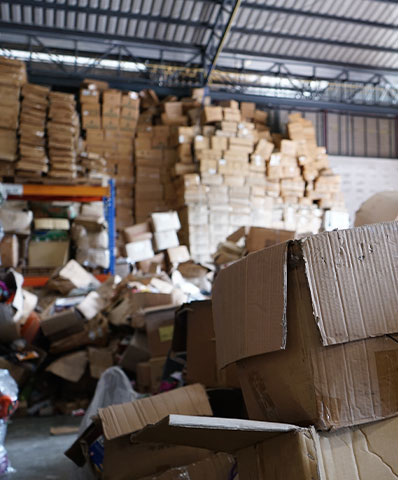For small businesses, managing inventory effectively is key to success. At the start, many businesses operate with minimal storage—spare rooms, garages, or small rented spaces often suffice. However, as a business grows, these storage solutions can quickly become a bottleneck, hindering efficiency and limiting the company’s potential. Recognizing the signs that it’s time to scale up and understanding the transition to a warehouse or shared facility can help small businesses streamline operations and prepare for future growth.
Signs It’s Time to Scale Up Your Storage Solutions
Inventory Is Out of Control
If products are spilling into aisles, stacked in unsafe ways, or taking over every available space, your current storage solution has reached its limits. Disorganized inventory can lead to inefficiencies, such as longer retrieval times, lost items, or damaged stock.
Difficulty Fulfilling Orders on Time
If you’re struggling to keep up with customer orders due to storage chaos, it’s a major red flag. Late or incorrect shipments can harm customer satisfaction alongside your brand’s reputation, ultimately impacting sales.

Growing Product Lines
As your business expands its offerings, the need for more storage space grows, too. If new products can’t fit into your current facility or require constant reshuffling of existing stock, it’s time to consider scaling up.
Seasonal Surges Create Overload
If seasonal fluctuations or promotions push your storage to the brink, causing delays or errors, it’s a sign that your current solution isn’t sustainable long-term.

Lack of Space for Operations
Efficient storage goes beyond shelving and bins—it requires space for packaging, order fulfillment, and even office functions. If your team is constantly navigating cramped conditions, productivity is taking a hit.
You’re Ready to Scale Up the Business
When growth becomes part of your strategic plan, your infrastructure must align with your ambitions. Scaling up warehousing or storage solutions ensures you’re prepared for increased demand and larger inventory levels without scrambling. And to do this correctly, turn to an experienced warehousing provider, like Corovan, who has helped many small businesses with their scalability initiatives.
Practical Steps for Transitioning to a Warehouse or Shared Facility
Once you’ve realized that it’s necessary to scale up, the next natural step is planning the transition. Here are practical tips to help small businesses take the leap.
Determine Your Needs
- Assess Current Inventory and Growth Projections: Understand how much space you currently need and factor in anticipated growth for the next 2–5 years.
- Identify Must-Have Features: Consider requirements such as loading docks, climate control, security, or proximity to shipping hubs.

Explore Different Warehouse Options
- Leasing a Dedicated Warehouse: If your business has steady growth, leasing a small warehouse may provide flexibility and control. Start with a smaller space and expand as needed.
- Shared Warehousing Facilities: For businesses with fluctuating storage needs, shared or co-warehousing facilities, like those offered by Corovan, offer a cost-effective option. These spaces allow you to rent only the space you need while sharing resources like equipment and staffing.
- Third-Party Logistics Providers (3PLs): A 3PL can manage warehousing, order fulfillment, and shipping, freeing you to focus on business growth without taking on the full responsibility of managing a warehouse.

Optimize Your Space from the Start
Once you transition, make the most of your new warehouse space.
- Invest in Smart Storage Solutions: Use vertical shelving, pallet racks, and organized zones to maximize efficiency.
- Implement Inventory Management Systems: Tools like barcode scanners and inventory software streamline stock tracking and order fulfillment.
Plan for Costs and Budgets
- Account for all expenses, including rent, utilities, labor, and equipment costs. Start with a space you can afford comfortably and scale up as business grows.
- Evaluate whether shared warehousing can provide savings, as you only pay for the space and services you use.
Streamline the Transition Process
Moving inventory can disrupt operations, so create a clear plan:
- Schedule the move during a slower period.
- Train staff on new warehouse workflows and systems to ensure a smooth transition.
- Partner with the professionals at Corovan for a seamless setup if moving large volumes of inventory.
The Benefits of Scaling Up
Investing in warehousing solutions can feel like a big leap, but the benefits often outweigh the challenges. A well-organized warehouse allows small businesses to:
- Improve Efficiency: Faster order fulfillment and streamlined operations lead to happier customers.
- Support Business Growth: Extra space allows you to expand product lines and handle larger order volumes.
- Support Business Growth: Extra space allows you to expand product lines and handle larger order volumes.

Have More Questions About Scaling Up Your Small Business?
Our experienced team can help. Get your free consultation today!
Learn MorePartner with an Experienced Warehousing Vendor
Recognizing the right time to scale up your storage solutions is a pivotal moment for any small business. By transitioning to a dedicated warehouse or shared facility, you can improve efficiency, streamline operations, and set the stage for long-term growth.
With over 75 years of experience, Corovan is the warehousing provider of choice for small businesses looking to scale seamlessly. We specialize in tailored commercial storage solutions that meet your unique needs—whether you’re expanding product lines, preparing for seasonal peaks, or simply outgrowing your current space. Let us help you take your business to the next level with reliable, flexible, and cost-effective warehousing solutions.
Contact Corovan today to learn how we can support your business growth year-round.
